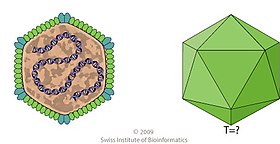

| Rhizidiovirus | |
|---|---|

| |
| Rhizidiomyces virus | |
| Virus classification | |
| (unranked): | Virus |
| Genus: | Rhizidiovirus |
| Species | |
| |
| Synonyms | |
|
Rhizidiomyces virus
| |
Rhizidiovirus is a genus of viruses. Stramenopiles[1] (specifically Hyphochytridiomycota) serve as natural hosts. There is only one species in this genus: Rhizidiomyces virus.[2][3]

Viruses in Rhizidiovirus are non-enveloped, with icosahedral, round, and isometric geometries. The diameter is around 60 nm.[2]
The genome is non segmented, linear double stranded DNA (dsDNA) and ~25.5 kilobases in length. It has a guanine + cytosine content of 42%. It encodes at least 14 protein with molecular weights between 84.5 and 26 kilodaltons.[citation needed]
| Genus | Structure | Symmetry | Capsid | Genomic arrangement | Genomic segmentation |
|---|---|---|---|---|---|
| Rhizidiovirus | Icosahedral | Non-enveloped | Linear | Monopartite |
The virus seems to remain latent within the host until the host is stressed.[4] Virons first appear in the nucleus. This is followed by the disintegration of the host nucleus and cytoplasm and their replacement by paracrystalline structures composed of virons. These structures first appear in association with the mitochondria. After the nucleus and cytoplasm have been replaced the cell wall breaks down followed with release of virons into the medium. Vertical transmission also appears to be possible.[citation needed]
DNA-templated transcription is the method of transcription. Fungi and hyphochytridiomycota serve as the natural host.[2]
| Genus | Host details | Tissue tropism | Entry details | Release details | Replication site | Assembly site | Transmission |
|---|---|---|---|---|---|---|---|
| Rhizidiovirus | Fungi Hyphochytridiomycota | None | Unknown | Lysis | Nucleus | Nucleus | Passive Diffusion, Vertical |
| Rhizidiovirus |
|
|---|---|
| Rhizidiomyces virus |
|